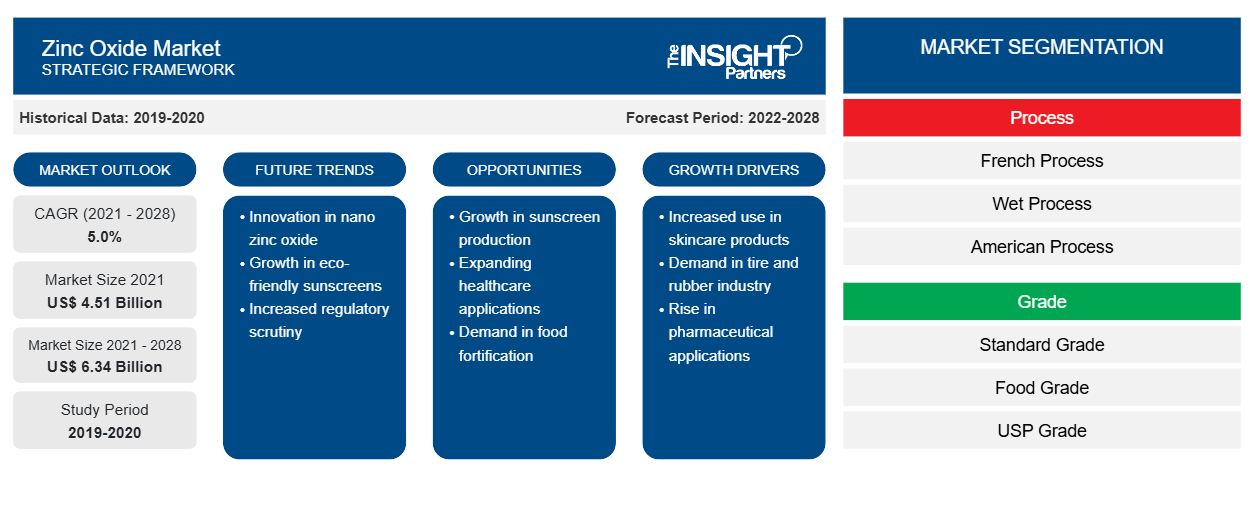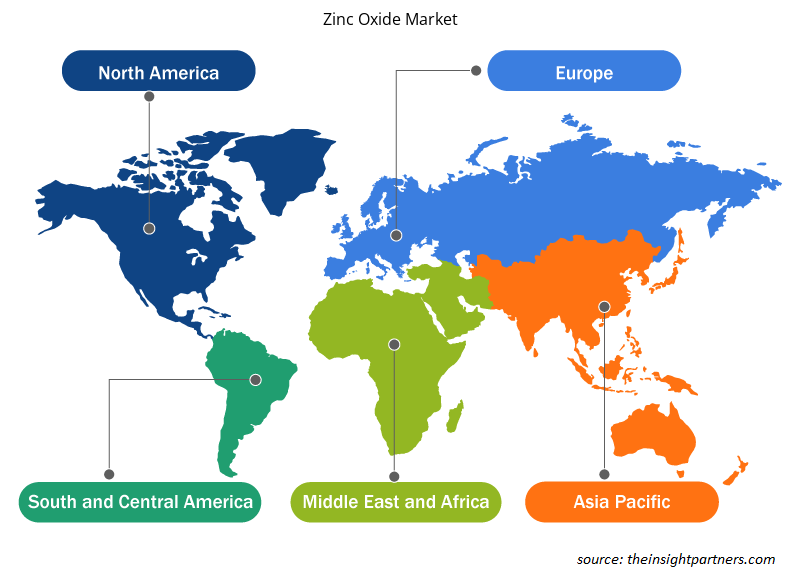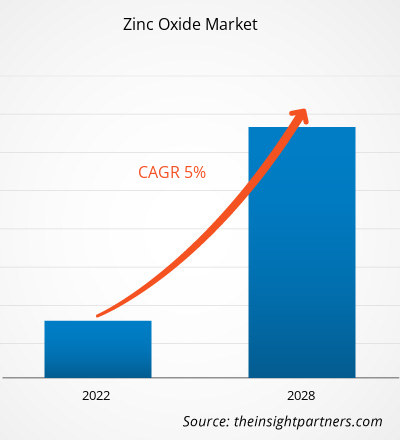The zinc oxide market size was valued at US$ 4,506.51 million in 2021 and is projected to reach US$ 6,338.82 million by 2028; it is expected to grow at a CAGR of 5.0% from 2021 to 2028.
Zinc oxide is an inorganic compound with the formula ZnO. It is a white powder that is insoluble in water, and it is widely used as an additive in numerous materials and products. Further, ZnO is used for the vulcanization of rubber to increase its durability. The tire industry further uses this vulcanized rubber for the manufacturing of tires. The rubber industry consumed more than half of the ZnO produced worldwide due to the growing production of tires. Further, increasing the production of smart devices and the utilization of zinc oxide in cosmetic products and personal care products, including makeup, baby lotions, powders, and bath soaps, are the key drivers of the zinc oxide market. It is also used as a bulking agent, a colorant, and a skin protectant in OTC drug products, such as sunscreen.
Further, zinc oxide is widely used as an additive for lubricating oils of automotive engines to reduce oxidation corrosion and wear. Zinc oxides are used to manufacture various types of lubricants, such as extreme-pressure lubricants, seizure-resistant lubricants, and greases. Thus, the above-mentioned products are high in demand, and respective industries are growing positively. For instance, in 2021, the cosmetic industry garnered around US$ 81 billion in revenue worldwide and registered around 8% growth compared to the previous year, as per the study by Statista. Similarly, in 2021, automotive lubricants have recorded 70.2 billion revenues, an increase of around 5% compared to 2020, as per the Statista report. Thus, the wide array of applications of zinc oxide is increasing its consumption rate and subsequently driving market growth.
Customize This Report To Suit Your Requirement
You will get customization on any report - free of charge - including parts of this report, or country-level analysis, Excel Data pack, as well as avail great offers and discounts for start-ups & universities
Zinc Oxide Market: Strategic Insights

- Get Top Key Market Trends of this report.This FREE sample will include data analysis, ranging from market trends to estimates and forecasts.
You will get customization on any report - free of charge - including parts of this report, or country-level analysis, Excel Data pack, as well as avail great offers and discounts for start-ups & universities
Zinc Oxide Market: Strategic Insights

- Get Top Key Market Trends of this report.This FREE sample will include data analysis, ranging from market trends to estimates and forecasts.
Impact of COVID-19 Pandemic on Zinc Oxide Market
The COVID-19 pandemic caused considerable disruptions in the growth of various industries globally. Similarly, the COVID-19 pandemic had a major impact on the zinc oxide market in 2020, when the supply chain of the zinc oxide raw material got hampered due to the restriction of goods transport. Eased lockdown norms in several countries and the growing pharmaceutical industry sustained global demand for zinc oxide. In addition to this, the rapid COVID-19 vaccinations program and rise in adoption of zinc oxide for medicinal products globally are flourishing the growth of the zinc oxide market, and manufacturers of zinc oxide are witnessing significant growth in their business.
Market Insights
Growing Demand for Green Zinc Oxide Nanoparticles in Agriculture
With the growing demand for chemical-free foods globally, green zinc oxide nanoparticle consumption is increasing since it is a safe alternative to conventional chemical methods without leaving any air pollutants. Zinc oxide nanoparticles are effective for germination and improve the development of plants. It also helps boost the growth rate of stem and roots without extracting soil nutrients. The demand for green zinc oxide nanoparticles gradually increases due to their soil reviving properties and increased crop yield.
Process Insights
Based on process, the global zinc oxide market is segmented into french process, wet process, american process, and others. The french process segment led the global zinc oxide market in 2020. The french process is also known as the indirect process; in this process, zinc is melted in a furnace and vaporized at 910 degrees. The immediate reaction of the zinc vapor with oxygen from the air produces zinc oxide.
Grade Insights
Based on grade, the zinc oxide market is segmented into standard grade, food grade, USP grade, and others. The standard grade segment led the global zinc oxide market in 2020. Standard grade zinc oxide is widely used in labs, research, and development sector as a reference standard while experimenting. The standard grade zinc oxide is high-quality and pure zinc oxide.
Zinc Oxide Market Regional Insights
The regional trends and factors influencing the Zinc Oxide Market throughout the forecast period have been thoroughly explained by the analysts at Insight Partners. This section also discusses Zinc Oxide Market segments and geography across North America, Europe, Asia Pacific, Middle East and Africa, and South and Central America.

- Get the Regional Specific Data for Zinc Oxide Market
Zinc Oxide Market Report Scope
| Report Attribute | Details |
|---|---|
| Market size in 2021 | US$ 4.51 Billion |
| Market Size by 2028 | US$ 6.34 Billion |
| Global CAGR (2021 - 2028) | 5.0% |
| Historical Data | 2019-2020 |
| Forecast period | 2022-2028 |
| Segments Covered |
By Process
|
| Regions and Countries Covered | North America
|
| Market leaders and key company profiles |
Zinc Oxide Market Players Density: Understanding Its Impact on Business Dynamics
The Zinc Oxide Market is growing rapidly, driven by increasing end-user demand due to factors such as evolving consumer preferences, technological advancements, and greater awareness of the product's benefits. As demand rises, businesses are expanding their offerings, innovating to meet consumer needs, and capitalizing on emerging trends, which further fuels market growth.
Market players density refers to the distribution of firms or companies operating within a particular market or industry. It indicates how many competitors (market players) are present in a given market space relative to its size or total market value.
Major Companies operating in the Zinc Oxide Market are:
- EverZinc
- L. Brügge
Disclaimer: The companies listed above are not ranked in any particular order.

- Get the Zinc Oxide Market top key players overview
Application Insights
Based on application, the global zinc oxide market is segmented into rubber, agriculture, chemicals and lubricants, glass and ceramic, paint and pigment, pharmaceutical, and others. The rubber segment led the global zinc oxide market in 2020. Rubber is being widely used in manufacturing various products such as tires and scrap tubes; the increasing use of rubber increases the market demand for zinc oxide. Zinc oxide is used in the rubber industry to prevent discoloration and maintain heat stability and product transparency.
EverZinc; L. Brüggemann GmbH & Co.; U.S. Zinc; Zochem, Inc.; Umicore; Grillo-Werke AG; Rubamin; JG Chemicals Pvt. Ltd.; Pan-Continental Chemical Co., Ltd.; and Akrochem Corporation are some players actively focusing on developing more innovative zinc oxide for various applications.
Report Spotlights
- Progressive zinc oxide market trends to help players develop effective long-term strategies
- Business growth strategies adopted by developed and developing markets
- Quantitative analysis of the zinc oxide market from 2019 to 2028
- Estimation of global demand for zinc oxide
- Porter's analysis to illustrate the efficacy of buyers and suppliers operating in the zinc oxide industry
- Recent developments to understand the competitive market scenario
- Market trends and outlook as well as factors driving and restraining the growth of the zinc oxide market
- Assistance in the decision-making process by highlighting market strategies that underpin commercial interest, leading to the market growth
- The size of the zinc oxide market at various nodes
- Detailed overview and segmentation of the market, as well as the zinc oxide industry dynamics
- Zinc oxide market size in various regions with promising growth opportunities
Frequently Asked Questions
What is the key driver for the growth of the global butyric acid market?
Growing demand for butyric acid from animal feed sector is one of the major driving factors for the market. Butyric acid is known for its beneficial effects on gut health and development. For decades, it has been in use in the animal feed industry for ensuring improved gut health and animal performance. The use of butyric acid in animal nutrition also helps in improving nutrient absorption.
Which region is anticipated to grow with the fastest CAGR for the butyric acid market?
Asia Pacific (APAC) is anticipated to grow with the fastest CAGR at rate of 15.3% from 2021 to 2028. The growing number of livestock farms in APAC is propelling animal feed consumption levels, subsequently leading to the proliferation of the butyric acid market.
What is the impact of COVID-19 on the butyric acid market?
Due to the COVID-19 pandemic, butyric acid manufacturers witnessed a slight disruption in the supply chain of butyric acid during the first two quarters of 2020. However, the supply chain of butyric acid materials has been restored, and production activities have regained normalcy in late 2020. Later, the market was not significantly negatively impacted by the pandemic. Further, with the growing COVID-19 vaccinations and eased in lockdown restrictions, the global economy is resuming, and subsequently, the butyric acid market is regaining its growth.
On the basis of application, which segment accounted for the largest share in the global butyric acid market?
Based on application, the animal feed segment accounted the largest share of the global butyric acid market. Butyric acid and fatty acids are extensively used in production of poultry and swine feed due to its beneficial properties such as improving digestibility, better colonisation resistance, and improved growth performance among young livestock.
Can you list some of the major players operating in the global butyric acid market?
The major players operating in the global butyric acid market are Eastman Chemical Company; OQ Chemicals GmbH; Tokyo Chemical Industry Co., Ltd.; Perstorp Holding AB; Alfa Aesar; MERCK KGaA; Vigon International, LLC.; Hefei TNJ Chemical Industry Co.,Ltd.; KUNSHAN ODOWELL CO.,LTD; and Yufeng International Co.,Ltd.
During the forecast period, which region is anticipated to account for the largest share of the global butyric acid market?
During the forecast period, Asia Pacific is anticipated to account for the largest share in the global butyric acid market. The region houses few of the fastest developing economies of the world such as China and India and that are the major consumer of the butyric acid. Moreover, in the Asia Pacific region, there is a growing number of livestock farms which is increasing the consumption of animal feed and subsequently proliferating the butyric acid market.
- Historical Analysis (2 Years), Base Year, Forecast (7 Years) with CAGR
- PEST and SWOT Analysis
- Market Size Value / Volume - Global, Regional, Country
- Industry and Competitive Landscape
- Excel Dataset
Testimonials
I wish to appreciate your support and the professionalism you displayed in the course of attending to my request for information regarding to infectious disease IVD market in Nigeria. I appreciate your patience, your guidance, and the fact that you were willing to offer a discount, which eventually made it possible for us to close a deal. I look forward to engaging The Insight Partners in the future, all thanks to the impression you have created in me as a result of this first encounter.
DR CHIJIOKE ONYIA, MANAGING DIRECTOR, PineCrest Healthcare Ltd.The Insight Partners delivered insightful, well-structured market research with strong domain expertise. Their team was professional and responsive throughout. The user-friendly website made accessing industry reports seamless. We highly recommend them for reliable, high-quality research services
Yukihiko Adachi CEO, Deep Blue, LLC.Reason to Buy
- Informed Decision-Making
- Understanding Market Dynamics
- Competitive Analysis
- Customer Insights
- Market Forecasts
- Risk Mitigation
- Strategic Planning
- Investment Justification
- Identifying Emerging Markets
- Enhancing Marketing Strategies
- Boosting Operational Efficiency
- Tracking Industry Innovations
- Aligning with Regulatory Trends
Yes! We provide a free sample of the report, which includes Report Scope (Table of Contents), report structure, and selected insights to help you assess the value of the full report. Please click on the "Download Sample" button or contact us to receive your copy.
Absolutely — analyst assistance is part of the package. You can connect with our analyst post-purchase to clarify report insights, methodology or discuss how the findings apply to your business needs.
Once your order is successfully placed, you will receive a confirmation email along with your invoice.
• For published reports: You’ll receive access to the report within 4–6 working hours via a secured email sent to your email.
• For upcoming reports: Your order will be recorded as a pre-booking. Our team will share the estimated release date and keep you informed of any updates. As soon as the report is published, it will be delivered to your registered email.
We offer customization options to align the report with your specific objectives. Whether you need deeper insights into a particular region, industry segment, competitor analysis, or data cut, our research team can tailor the report accordingly. Please share your requirements with us, and we’ll be happy to provide a customized proposal or scope.
The report is available in either PDF format or as an Excel dataset, depending on the license you choose.
The PDF version provides the full analysis and visuals in a ready-to-read format. The Excel dataset includes all underlying data tables for easy manipulation and further analysis.
Please review the license options at checkout or contact us to confirm which formats are included with your purchase.
Our payment process is fully secure and PCI-DSS compliant.
We use trusted and encrypted payment gateways to ensure that all transactions are protected with industry-standard SSL encryption. Your payment details are never stored on our servers and are handled securely by certified third-party processors.
You can make your purchase with confidence, knowing your personal and financial information is safe with us.
Yes, we do offer special pricing for bulk purchases.
If you're interested in purchasing multiple reports, we’re happy to provide a customized bundle offer or volume-based discount tailored to your needs. Please contact our sales team with the list of reports you’re considering, and we’ll share a personalized quote.
Yes, absolutely.
Our team is available to help you make an informed decision. Whether you have questions about the report’s scope, methodology, customization options, or which license suits you best, we’re here to assist. Please reach out to us at sales@theinsightpartners.com, and one of our representatives will get in touch promptly.
Yes, a billing invoice will be automatically generated and sent to your registered email upon successful completion of your purchase.
If you need the invoice in a specific format or require additional details (such as company name, GST, or VAT information), feel free to contact us, and we’ll be happy to assist.
Yes, certainly.
If you encounter any difficulties accessing or receiving your report, our support team is ready to assist you. Simply reach out to us via email or live chat with your order information, and we’ll ensure the issue is resolved quickly so you can access your report without interruption.















The List of Companies - Zinc Oxide Market
- EverZinc
- L. Brüggemann GmbH & Co.
- U.S. Zinc.
- Zochem, Inc.
- Umicore
- Grillo-Werke AG
- Rubamin
- JG Chemicals Pvt. Ltd.
- Pan-Continental Chemical Co., Ltd.
- Akrochem Corporation






 Get Free Sample For
Get Free Sample For